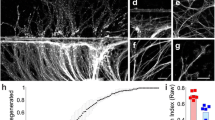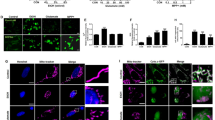Abstract
Some crustacean axons remain functional for months after injury. This unusual property may require stress proteins synthesized by those neurons or provided to them by glial cells. To begin to explore this hypothesis, we examined the conditions that stimulated stress protein synthesis by crayfish CNS tissue in vitro. Incubation for 1–15 h with arsenite or at temperatures about 15°C higher than the acclimation temperature of 20°C induced transient expression of several stress proteins. The heat stress response was blocked by Actinomycin D, suggesting that synthesis of new mRNA was required. In addition, the major crayfish 66 kD stress protein and its mRNA had sequence identities with the 70 kD stress proteins of mammals. Since the crayfish stress response has much in common with that of other organisms, the unique advantages of the crayfish nervous system can be used to study the impact of stress proteins on glial and neuronal function.
Similar content being viewed by others
References
Bittner, G. D. 1973. Degeneration and regeneration in crustacean neuromuscular systems. Amer. Zool. 13:379–408.
Bittner, G. D. 1977. Trophic interactions of crustacean neurons, Pages 507–532, in Hoyle, G. (ed.) Identified Neurons and Behavior.
Bittner, G. D. 1981. Trophic interactions of CNS giant axons in crayfish. Comp. Biochem. Physiol. 68A:299–306.
Bittner, G. D. 1988. Long-term survival of severed distal axonal stumps in vertebrates and invertebrates. Amer. Zool. 28:1165–1179.
Hoy, R. R. 1973. The curious nature of degeneration and regeneration in motor neurons and central connectives of the crayfish, Pages 203–232, in Young, D. (ed.) Developmental Neurobiology of Arthropods. Cambridge University Press.
Atwood, H. L., Govind, C. K., and Bittner, G. D. 1973. Ultrastructure of nerve terminals and muscle fibers in denervated crayfish muscle. Z. Zellforsch. 146:155–165.
Bittner, G. D. 1973. Trophic dependence of fiber diameter in a crustacean muscle. Exp. Neurol. 41:38–53.
Bouton, M. S., and Bittner, G. D. 1981. Regeneration of motor axons in crayfish limbs: distal stump activation followed by synaptic reformation. Cell Tissue Res. 219:379–392.
Wine, J. J. 1973. Invertebrate central neurons: orthograde degeneration and retrograde changes after axonotomy. Exp. Neurol. 38:157–169.
Wine, J. J. 1973. Invertebrate synapse: long-term maintenance of post-synaptic morphology following denervation. Exp. Neurol. 41:649–660.
Nordlander, R., and Singer, M. 1973. Degeneration and regeneration of severed crayfish sensory fibers: an ultrastructural study. J. Comp. Neurol. 152:175–192.
Burdon, R. H. 1986. Heat shock and the heat shock proteins. Biochem. J. 240:313–324.
Flynn, G. C., Chappell, T. G., and Rothman, J. E. 1989. Peptide binding and release by proteins implicated as catalysts of protein assembly. Science 245:385–390.
Lindquist, S., and Craig, E. A. 1988. The heat-shock proteins. Annu. Rev. Genet. 22:631–677.
Schlesinger, M. J. 1986. Heat shock proteins: the search for functions. J. Cell Biol. 103:321–325.
Subjeck, J. R., and Shyy, T. T. 1986. Stress protein systems of mammalian cells. Am. J. Physiol. 250:C1-C17.
Welch, W. J., Mizzen, L. A., and Arrigo, A.-P. 1989. Structure and function of mammalian stress proteins, Pages 187–202, in Pardue, M. L., Feramisco, J. R., and Lindquist, S. (eds) UCLA Symp. Molec. Cell Biol., Vol. 96, Stress-Induced Proteins. Alan R. Liss, New York.
Barbe, M. F., Tytell, M., Gower, D. J., and Welch, W. J. 1988. Hyperthermia protects against light damage in the rat retina. Science 241:1817–1820.
Chopp, M., Chen, H., Ho, K.-L., Dereski, M. O., Brown, E., Hetzel, F. W., and Welch, K. M. A. 1989. Transient hyperthermia protects against subsequent forebrain ischemic cell damage in the rat. Neurol. 39:1396–1398.
Finley, D., Ozlaynak, E., and Varshavsky, A. 1987. The yeast polyubiquitin gene is essential for resistance to high temperatures, starvation, and other stresses. Cell 48:1035–1046.
Johnston, R. N., and Kucey, B. L. 1988. Competitive inhibition of hsp70 gene expression causes thermosensitivity. Science 242:1551–1554.
Loomis, W. F., and Wheeler, S. A. 1982. Chromatin-associated heat shock proteins of Dictyostelium. Dev. Biol. 90:412–418.
Pelham, H. R. B. 1984. Hsp 70 accelerates the recovery of nucleolar morphology after heat shock. EMBO J. 3:3095–3100.
Riabowol, K. T., Mizzen, L. A., and Welch, W. J. 1988. Heat shock is lethal to fibroblasts microinjected with antibodies against hsp 70. Science 242:433–436.
Sanchez, Y., and Lindquist, S. L. 1990. Hsp 104 required for induced thermotolerance. Science 248:1112–1115.
Tytell, M., Greenberg, S. G., and Lasek, R. J. 1986. Heat shock-like protein is transferred from glia to axon. Brain Res. 363:161–164.
Meyer, M. R., and Bittner, G. D. 1978. Biochemical studies of trophic dependencies in crayfish giant axons. Brain Res. 143:213–232.
Moehlenbruck, J. W., Zeagler, J. W., Seshan, K. R., Sheller, R. A., and Bittner, G. D. 1986. Mechanisms for long-term survival of enucleated axons. I. Intercellular protein transfer. Trans. Soc. Neurosci. 12:1151.
Hakimzadeh, R., and Bradley, B. P. 1990. The heat shock response in the copepod Eurytemora affinis (Poppe). J. Therm. Biol. 15:67–78.
McLennan, A. G., and Miller, D. 1990. A biological role for the heat shock response in crustaceans. J. Therm. Biol. 15:61–66.
Stone, G. C. and Dougher, M. M. 1988. Heat stress induces changes in protein synthesis and fast axonal transport in bullfrog sensory neurons. J. Neurochem. 51:960–966.
Grossfeld, R. M., Klinge, M. W., Lieberman, E. M., and Stewart, L. C. 1988. Axon-glia transfer of a protein and a carbohydrate. Glia 1:292–300.
Mizzen, L. A., and Welch, W. J. 1988. Characterization of the thermotolerant cell. I. Effects on protein synthesis activity and the regulation of heat-shock protein 70 expression. J. Cell Biol. 106:1105–1116.
Hames, B. D., and Rickwood, D. (eds.) 1981. Gel Electrophoresis of Proteins. IRL Press, Oxford.
Mans, R. J., and Novelli, G. D. 1961. Measurement of the incorporation of radioactive amino acids into protein by a filter-paper disk method. Arch. Biochem. Biophys. 94:48–53.
Chomczynski, P., and Sacchi, N. 1987. Single-step method of RNA isolation by acid guanidinium thiocyanate-phenol-chloroform extraction. Anal. Biochem. 162:156–159.
Nishimura, R. N., Dwyer, B. E., Clegg, K., Cole, R., and de Vellis, J. 1991. Comparison of the heat shock response in cultured cortical neurons and astrocytes. Mol. Br. Res. 9:39–45.
Allen, J. M., Sasek, C. A., Martin, J. B., and Heinrich, G. 1987. Use of complementary125I-labeled RNA for single cell resolution by in situ hybridization. BioTechniques 5:774–777.
Harper, M. E., and Marselle, L. M. 1987. RNA detection and localization in cells and tissue sections by in situ hybridization of 35S-labeled RNA probes Pages 539–551, in Gottesman, M. M. (ed.) Meth. Enzymol., Vol. 151. Academic Press, NY.
Nishimura, R. N., Dwyer, B. E., Welch, W., Cole, R., de Vellis, J., and Liotta, K. 1988. The induction of the major heat-stress protein in purified rat glial cells. J. Neurosci. Res. 20:12–18.
Brown, I. R., and Rush, S. J. 1984. Induction of a ‘stress’ protein in intact mammalian organs after the intravenous administration of sodium arsenite. Biochem. Biophys. Res. Commun. 120:150–155.
Brown, I. R., Lowe, D. G., and Moran, L. A. 1985. Expression of heat shock genes in fetal and maternal rabbit brain. Neurochem. Res. 10:1277–1284.
Gower, D. J., Hollman, C., Lee, K. S., and Tytell, M. 1989. Spinal cord injury and the stress protein response. J. Neurosurg. 70:605–611.
Nowak, T. S. Jr. 1985. Synthesis of a stress protein following transient ischemia in the gerbil. J. Neurochem. 45:1635–1641.
Nowak, T. S. Jr., Bond, U., and Schlesinger, M. J. 1990. Heat shock RNA levels in brain and other tissues after hyperthermia and transient ischemia. J. Neurochem. 54:451–458.
Gonzalez, M. F., Shiraishi, K., Hisanaga, K., Sagar, S. M., Mandabach, M., and Sharp, F. R. 1989. Heat shock proteins as markers of neural injury. Mol. Brain Res. 6:93–100.
Brown, I. R., Rush, S., and Ivy, G. O. 1989. Induction of a heat shock gene at the site of tissue injury in the rat brain. Neuron 2:1559–1564.
Magnusson, K., and Wieloch, T. 1989. Impairment of protein ubiquitination may cause delayed neuronal death. Neurosci. Lett. 96:264–270.
Mansing, T. E., and Brown, I. R. 1989. Cellular localization of heat shock gene expression in rabbit cerebellum by in situ hybridization with plastic-embedded tissue. Neurochem. Res. 14:725–731.
Vass, K., Welch, W. J., and Nowak, T. S. Jr. 1988. Localization of 70-kDa stress protein induction in gerbil brain after ischemia. Acta Neuropathol. 77:128–135.
Atwood, H. L., Lang, F., and Morin, W. A. 1972. Synaptic vesicles: selective depletion in crayfish excitatory and inhibitory axons. Science 176:1353–1355.




